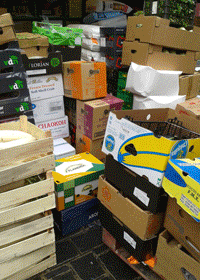Our first 'theory-Friday' (as I like to call it!) lecture was entitled 'Psychogeography: alternative ways of mapping'. It was centred around the idea of reimagining the City, asking how a space impacts on our state of being, and thinking how we might find ways to see an area differently.
The lecture introduced us to the idea of 'the Flaneur'. As I found during my Rough Guide research, cities are places of movement. The pace of life in London is generally fast, and standing around to sketch for the Rough Guide did get me some odd looks, as people are usually aiming to reach a certain destination as quickly as possible. The concept of Flanerie, however, is to slow down and observe. Rather than being part of the bustling crowd, lost in a flood of tired looking commuters, the aim is to rediscover the detail and wonder of the City that is already around us. So as the lecture ended, we were sent out to do just that: to go and be a Flaneur in London!
Placing my bottle at random on a map of the area and drawing round it to dictate our route, Helen and I set out to go and rediscover the City. There wasn't much chance of getting caught by the speed camera at our nice, leisurely pace.
We soon came across some very peaceful spaces just away from the main road, that we'd never passed before...and the sun was actually shining, making the walk very enjoyable!


Tying in with this week's lecture, I visited the Museum of London, which boldly declares "London- the City of the People" on one gallery wall. So, as we walked around, I was interested in stopping to talk to people, and looking for places where people had tried to personalise the space somehow. We met one elderly lady who we were able to help open a tin that she had been struggling with, and went into a bakery to speak to the shop assistant after noticing that one of the cakes in the window had fallen over. Simply walking and observing gave us the oppertunity to have these encounters, which we would have probably missed on a planned journey somewhere. I really liked this little star decoration we spotted hanging outside someone's door. If Flanerie is about breaking away from normality and finding fun in the familiar with fresh eyes, then surely little artistic interventions like this are exactly what we need more of in the City!

After getting on a random bus for four stops, then continuing to follow our route, Helen and I found ourselves the other side of the river. And guess whose street we came across...? (mine!)
As I'm using the idea of 'playing around' for my Box Clever project, this exercise in disrupting the normality of being in a space, was quite useful. It was a reminder of the interesting and unexpected things that can happen when you retain a playful approach and take the time to notice what is really around you.






















































